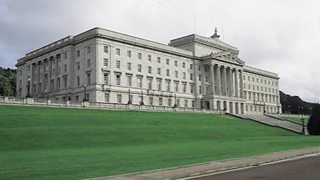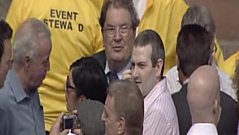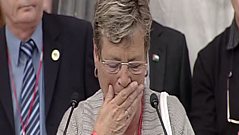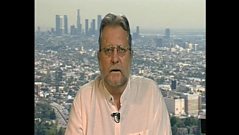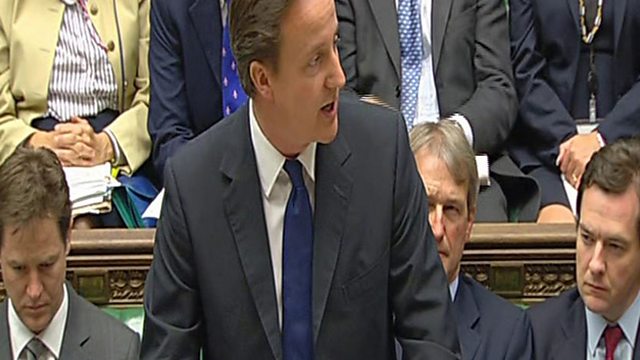
David Cameron responds to the Saville Report
While David Cameron responds to Lord Saville’s findings on Bloody Sunday to a packed House of Commons, crowds in Londonderry watch him with rapt attention on a big screen.
This section of the programme begins with a relative of one of the Bloody Sunday victims (please see context below) giving a thumbs-up sign through a window of the Guildhall.
The crowd in Guildhall Square are cheering and clapping.
Other members of victims’ families wave to the crowd from inside the Guildhall.
In the 91�ȱ�’s Stormont studio Jim Fitzpatrick and Denis Murray (the former 91�ȱ� Ireland Correspondent) infer this must mean the families are happy with the conclusions of Lord Saville’s inquiry into the events of Bloody Sunday.
In the square giant blank and white portraits of the victims are carried up to the front of the crowd.
Footage cuts from the square to the House of Commons where Prime Minister David Cameron is starting to make his statement; seated behind him are (left to right) Nick Clegg (Deputy Prime Minster), Owen Paterson (Secretary of State for Northern Ireland) and George Osborne (Chancellor of the Exchequer).
The link at the bottom of this page to Hansard (which provides printed transcripts of parliamentary debates in Westminster) takes you to a transcript of the Prime Minister’s speech.
CONTEXT
On 30 January 1972 soldiers from the 1st Parachute Regiment killed 13 innocent civil rights demonstrators in Derry.
The period from August 1971 to January 1972 saw a sustained campaign of anti-internment protests. On 22 January, John Hume led an illegal demonstration along Magilligan Strand just outside Londonderry, towards a nearby internment camp. The marchers were confronted by soldiers of the 1st Parachute Regiment who drove them off the beach using baton charges and rubber bullets.
It was these same paratroopers who were sent into Derry eight days later to deal with another banned protest. This march was organised by the Northern Ireland Civil Rights Association (NICRA). Some ten thousand people gathered in the Creggan estate and proceeded towards Guildhall Square in the centre of the city. The paratroopers had sealed off the approaches to the Square and the march organisers, in order to avoid trouble, led most of the demonstrators towards Free Derry Corner in the Bogside.
Groups of local youths (referred to by the security forces as ‘YDHs’ – Young Derry Hooligans) stayed behind at the Army barricades to confront the soldiers. The soldiers were ordered to move in and arrest as many of the rioters as possible. Just after four o'clock, the paratroopers made their move. What took place next was totally unexpected: the paratroopers opened fire on the crowd, killing thirteen men and injuring thirteen others; one of the injured died some time later.
The soldiers claimed that they had been fired on as they moved in to make arrests. As far as the people of the Bogside and further afield were concerned, the Army had summarily executed thirteen unarmed, innocent civilians. The Widgery Tribunal, which had been set up to investigate the circumstances surrounding the killings, later concluded that: ‘At one end of the scale, some soldiers showed a high degree of responsibility; at the other end.... firing bordered on the reckless’.
The Londonderry Coroner, Major Hubert O'Neill, did not share Lord Widgery's conclusion. At the end of the inquest in 1973, which is still seen by nationalists as a cover up for murder, O'Neill said, “It strikes me that the army ran amok that day and they shot without thinking what they were doing… I say it without reservation - it was sheer unadulterated murder”.
The British government later made out-of-court settlements with the bereaved families
In 1998 the Labour government launched an in-depth investigation chaired by Lord Saville of Newdigate. The Saville Inquiry, which was the most expensive investigation of its kind in the United Kingdom, reported in June 2010.
It concluded that none of the dead posed a threat and the actions of the soldiers were totally without justification. The Prime Minister David Cameron apologised on behalf of the nation for the “unjustified and unjustifiable killings”.
Duration:
This clip is from
More clips from Stormont Live Special - The Saville Inquiry Report
-
![]()
Publication of Saville Report
Duration: 11:42
-
![]()
Relatives of Bloody Sunday victims
Duration: 27:09
-
![]()
Early political reaction to the Saville report
Duration: 09:16
-
![]()
Interview with Tony Clarke
Duration: 03:41
